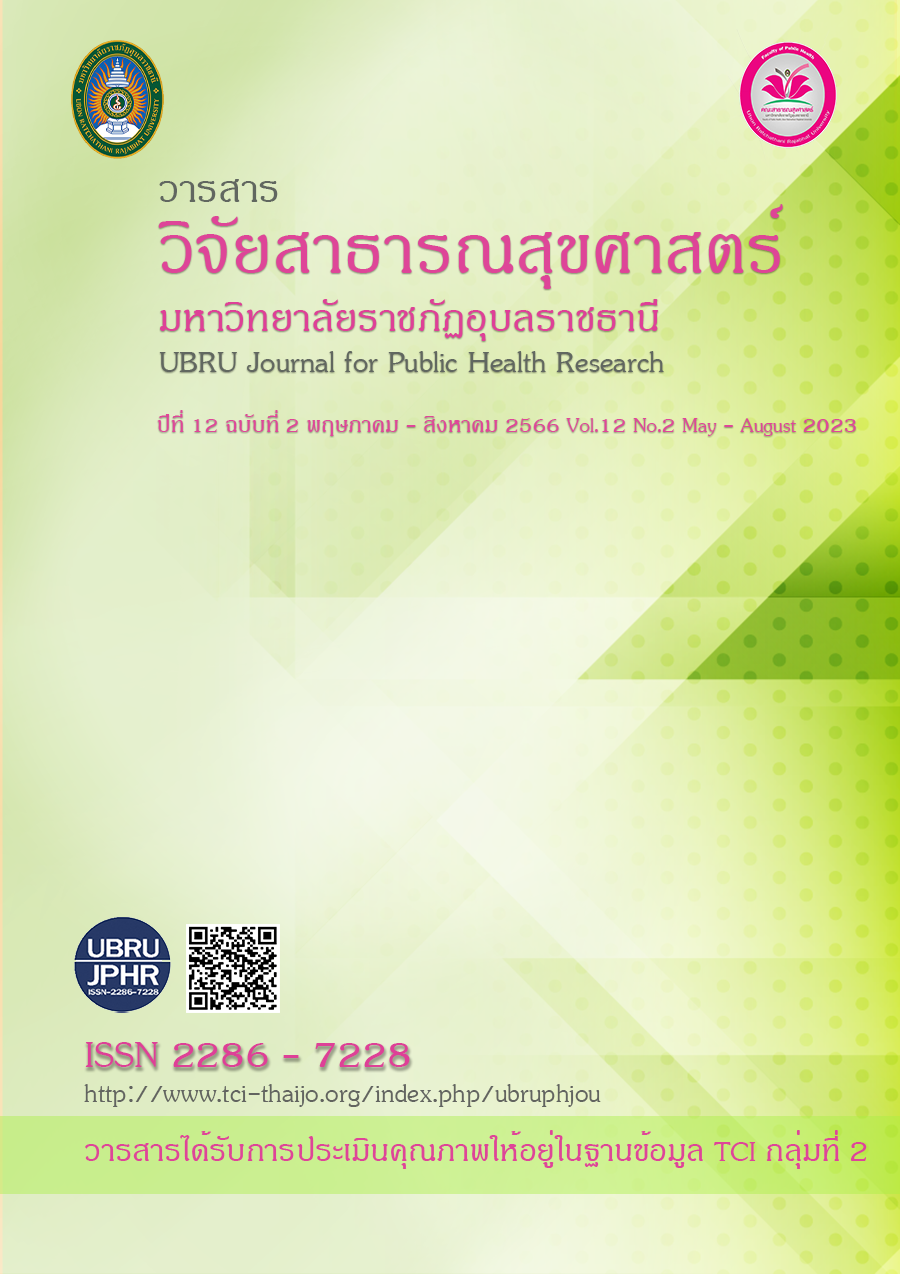การประเมินความเสี่ยงจากการทำงานในแรงงานนอกระบบกลุ่มเย็บผ้า กรณีศึกษา ตำบลไผ่ใหญ่ อำเภอม่วงสามสิบ จังหวัดอุบลราชธานี
คำสำคัญ:
แรงงานนอกระบบ, แรงงานนอกระบบ/ การวิเคราะห์งานเพื่อความปลอดภัย/งานเย็บผ้า, งานเย็บผ้าบทคัดย่อ
การศึกษานี้มีวัตถุประสงค์เพื่อประเมินความเสี่ยงจากการทำงานในแรงงานนอกระบบกลุ่มเย็บผ้า ในกระบวนการผลิตมุ้ง จำนวน 34 คน เครื่องมือที่ใช้ คือ แบบสอบถาม และแบบประเมินความเสี่ยงด้วยเทคนิค JSA วิเคราะห์ข้อมูลด้วยสถิติพรรณนา
ผลการศึกษา พบว่า ปัจจัยคุกคามจากสภาพแวดล้อมในการทำงาน ได้แก่ 1) ด้านเคมีจากฝุ่นผ้า ร้อยละ 100.00 และสารเคมีในการตกแต่งผ้า ร้อยละ 91.20 2) ด้านการยศาสตร์ จากการก้มเงยศีรษะขณะทำงาน ร้อยละ 97.10 การก้มโค้งตัว การบิดเอี้ยวตัว ร้อยละ 94.10 3) ด้านกายภาพ จากอุปกรณ์ เครื่องจักรเสียงดัง ร้อยละ 73.50 อุปกรณ์ เครื่องจักรมีแรงสั่นสะเทือน ร้อยละ 70.60 4) ด้านจิตวิทยาสังคม จากค่าตอบแทนไม่แน่นอน ร้อยละ 94.10 การทำงานเร่งรีบ ร้อยละ 73.50 และ 5) อุบัติเหตุจากเครื่องมือ เครื่องจักร เครื่องใช้ไฟฟ้า และของมีคม ร้อยละ 88.20 ผลการประเมินความเสี่ยง ด้วยเทคนิค JSA พบว่า ระดับคะแนนความเสี่ยงสูงสุด เท่ากับ ระดับ 3 (ความเสี่ยงสูง ต้องมีการดำเนินการเพื่อลดความเสี่ยง) ได้แก่ ความร้อนจากสภาพแวดล้อม การสัมผัสฝุ่นผ้า การนั่งทำงานนานต่อเนื่อง และการบิดเอี้ยวลำตัว
จากการประเมินความเสี่ยงด้วย JSA พบว่า กลุ่มตัวอย่างมีความเสี่ยงสูง จากสิ่งคุกความด้านกายภาพ เคมี และด้านการยศาสตร์ ซึ่งความเสี่ยงด้านการยศาสตร์ ถือเป็นปัจจัยสำคัญที่ทำให้เกิดการบาดเจ็บระบบกระดูกกล้ามเนื้อ และความไม่สบายในการทำงาน แนวทางการศึกษาครั้งต่อไปควรมุ่งศึกษาในด้านการยศาสตร์
เอกสารอ้างอิง
จัดพล ภัยแคล้ว, สงวน วงษ์ชวลิตกุล, มารุต โครตพันธ. (2563). การประยุกต์ใช้เทคนิคการชี้บ่งอันตรายทุกการดำเนินงานของโรงงานอุตสาหกรรม กรณีศึกษาโรงงานอุตสาหกรรมในเขตจังหวัดนครราชสีมา. วารสารวิทยาศาสตร์และเทคโนโลยี มหาวิทยาลัยมหาสารคาม. 633-644.
ชวพรพรรณ จันทร์ประสิทธิ์, วรันธรณ์ จงรุ่งโรจน์สกุล, ธานี แก้วธรรมานุกูล, รุจาธร อินทรตุล. (2563). ปัจจัยด้านการยศาสตร์และความชุกของอาการผิดปกติระบบโครงร่างกล้ามเนื้อในแรงงานนอกระบบตัดเย็บผ้า. พยาบาลสาร. 47(2), 64-74.
นิชนันท์ ชินรัตน์, อุไรวรรณ อินทร์ม่วง. (2562). การประเมินความเสี่ยงสุขภาพของแรงงานนอกระบบกลุ่มเย็บผ้าสำเร็จรูปอำเภอหนองเรือ จังหวัดขอนแก่น. สำนักงานป้องกันควบคุมโรคที่ 7 ขอนแก่น. 26(1), 97-108.
ประกายน้ำ มากศรี, ชวพรพรรณ จันทร์ประสิทธิ์, ธานี แก้วธรรมานุกูล. (2561). ปัจจัยคุกคามสุขภาพจากการทำงานและภาวะสุขภาพตามความเสี่ยงของแรงงานนอกระบบตัดเย็บผ้า. พยาบาลสาร. 45(4), 71-83.
ระเบียบกรมโรงงานอุตสาหกรรม ว่าด้วยหลักเกณฑ์การชี้บ่งอันตราย การประเมินความเสี่ยง และการจัดทำแผนบริหารจัดการความเสี่ยง พ.ศ. 2543. 17 พฤศจิกายน 2543.
สุนิสา ชายเกลี้ยง, ธวัชชัย คำป้อง, วรวรรณ ภูชาดา. (2560). การประเมินความเสี่ยงต่อสุขภาพด้านการสัมผัสปัจจัย การยศาสตร์ของแรงงานนอกระบบกลุ่มเย็บผ้าสำเร็จรูป. วารสารสาธารณสุขมหาวิทยาลัยบูรพา.12(1), 99-111.
สุวิทย์ อินนามมา. (2553). แรงงานนอกระบบ วิถีชีวิตการทำงาน การดูแลสุขภาพและสังคม กรณีศึกษากลุ่มเย็บผ้า ตำบลบ้านเม็ง อำเภอหนองเรือ จังหวัดขอนแก่น. วารสารวิจัยสาธารณสุขศาสตร์. 4(3), 379-392.
อาภรณ์ทิพย์ บัวเพ็ชร์, สุรินธร กลัมพากร, สุนีย์ ละกำาปั่น. (2555). ปัจจัยสิ่งแวดล้อมในการทำงานด้านจิตสังคมที่มีความสัมพันธ์กับปัญหาสุขภาพจิตและความพึงพอใจในงานของพนักงานโรงงานตัดเย็บเสื้อผ้าขนาดใหญ่. วารสารสาธารณสุขศาสตร์. 42(1), 5-17.
กระทรวงดิจิทัลเพื่อเศรษฐกิจและสังคม. (2664). สรุปผลที่สำคัญ การสำรวจแรงงานนอกระบบ พ.ศ. 2564. [อินเทอร์เน็ต].กรุงเทพมหานคร: สำนักงานสถิติแห่งชาติ [เข้าถึงเมื่อ 20 พ.ย. 2565]. เข้าถึงได้จาก: https://shorturl.asia/UfVvp
Ekta and Manju Mehta. (2020). A study on work-related musculoskeletal disorders among sewing machine operators. Indian Journal of Health and Well-being.11(1-3), 08-12.
Sealetsaa, Thatcher. (2011). Ergonomics issues among sewing machine operators in the textile manufacturing industry in Botswana. Work, 279-289.
Iman Dianat, Madeh Kord, Parvin Yahyazade, Mohammad Karimi Alex Stedmon. (2015). Association of individual and work-related risk factors with musculoskeletal symptoms among Iranian sewing machine operators. Applied Ergonomics. 51, 180-188.
Nilufer OzturkMelek, Nihal EsinAndersen. (2011). Investigation of musculoskeletal symptoms and ergonomic risk factors among female sewing machine operators in Turkey. International journal of industrial ergonomics. 41, 585-590.
ดาวน์โหลด
เผยแพร่แล้ว
รูปแบบการอ้างอิง
ฉบับ
ประเภทบทความ
สัญญาอนุญาต
ลิขสิทธิ์ (c) 2023 คณะสาธารณสุขศาสตร์ มหาวิทยาลัยราชภัฏอุบลราชธานี

อนุญาตภายใต้เงื่อนไข Creative Commons Attribution-NonCommercial-NoDerivatives 4.0 International License.
เนื้อหาและข้อมูลในบทความที่ลงตีพิมพ์ในวารสารวารสารวิจัยสาธารณสุขศาสตร์ มหาวิทยาลัยราชภัฏอุบลราชธานี ถือเป็นข้อคิดเห็นและความรับผิดชอบของผู้เขียนบทความโดยตรงซึ่งกองบรรณาธิการวารสาร ไม่จำเป็นต้องเห็นด้วย หรือร่วมรับผิดชอบใดๆ
บทความ ข้อมูล เนื้อหา รูปภาพ ฯลฯ ที่ได้รับการตีพิมพ์ในวารสารนี้ ถือเป็นลิขสิทธิ์ของวารสารฯ หากบุคคลหรือหน่วยงานใดต้องการนำทั้งหมดหรือส่วนหนึ่งส่วนใดไปเผยแพร่ต่อหรือเพื่อกระทำการใดๆ จะต้องได้รับอนุญาตเป็นลายลักอักษรณ์จากบรรณาธิการวารสารนี้ก่อนเท่านั้น


